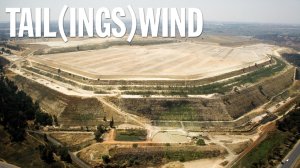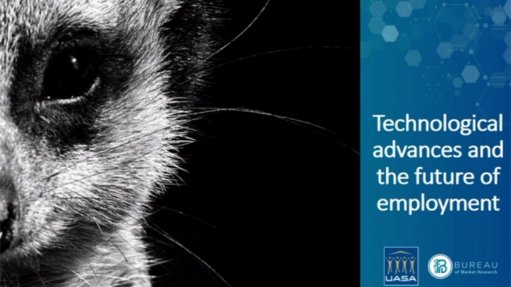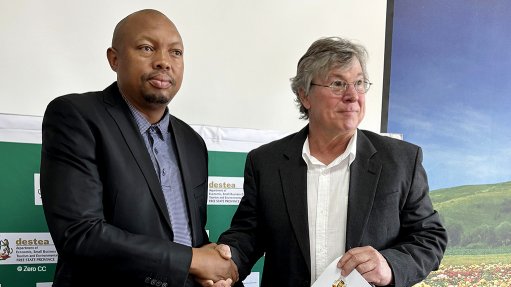Unlocking social and environmental benefits through tailings retreatment
The retreatment, or remining, of mine tailings can provide usable land, provide profits for companies and clean the environment by moving the reprocessed tailings to more advanced and well-managed facilities.
Owing to changes in legislation, tailings need to be stored in facilities that are better managed and controlled than historical facilities. This means that the tailings from remined sites are sent to new tailing storage facilities (TSFs), said specialist consulting engineering firm Jones & Wagener environmental engineering closure and rehabilitation associate civil engineer Alice Harvey.
"Typically, existing tailings are present in smaller facilities, but are being sent to be managed more centrally in larger facilities. Processes have changed, stability assessments have improved significantly and facilities are required to be aligned to certain standards to have a much lower, or no, impact on water quality, compared to the historical facilities," she said.
The tailings facilities or mine dumps that have not been rehabilitated still have existing safety risks and environmental impacts that are not being managed. However, if these facilities and dumps are seen as a resource and remined, then there is more control over and management of the risks, she noted.
There are about 6 000 unrehabilitated, dormant or abandoned mining dumps and tailings facilities in South Africa, and about 337 of them are at high risk and need immediate attention, said Southern African Institute of Mining and Metallurgy tailings committee member, hydrogeologist and mine water strategist Dr Kym Morton.
In the industry, mining houses are finding that increasing their efforts in managing their TSFs and retreatment of tailings is an opportunity to improve their social licence.
People in South Africa are familiar with seeing mine dumps daily, especially in Johannesburg, Welkom and along the Witwatersrand belt. There are massive opportunities for South Africa in the way it manages active and abandoned TSFs, including for the minerals in them and potentially to use the materials as building materials, she said.
JSE-listed gold miner DRDGold is processing about 500 000 tonnes a month from one site and recovering about 30 kg of gold. This gives an indication of the throughput that must be maintained to have a financially viable model, highlighted DRDGold CEO Niël Pretorius.
Tailings from multiple smaller sites, usually tens of kilometres apart, need to be transported, processed and then moved to a central tailings site. These operations typically require liquefying the tailings, pumping them and then dewatering them again. Therefore, partner companies are usually involved and a holistic approach to designing the flowsheet must be taken, said minerals and mining engineering company Weir Minerals tailings and backfill global manager Erik Vlot.
No materials that DRDGold reclaims in the Johannesburg area and West Rand are sent back to their original sites where they were reclaimed from. The materials, once processed, are sent to a large central facility, where they are managed to a stricter set of health and environmental standards than when the tailings sites were initially established, said Pretorius.
"South Africa has about 120 years of tailings accumulation on the surface in a small area. Once there is a resource of adequate size, then it is a matter of setting up the technology and logistical infrastructure in such a way that you can process at the requisite throughput rate," he said.
Healthy Land
But, while operations must be commercially viable, remining and storing tailings more securely is a long-term sustainability game of incrementally creating an environment that is healthier and more pleasant to live in and near, Pretorius said.
Either remining and rehabilitating sites, or rehabilitating sites in situ can provide footprints of land that can be used for alternative applications, said Harvey.
"A contaminated land assessment needs to be done to understand the impact on the land, but, once the tailings are gone, the assessment complete and the contamination is removed, then the land can effectively be reused," she said.
The intended use for the land post closure should be defined early on in the process to ensure that the process achieves what is required for the footprint to be used for the post-closure purpose, she added.
By reclaiming materials and removing them, the source of the nuisance and risks to communities is removed as the site is progressively cleared. The aim then is to ensure the sites are put to sustainable use so that one problem is not replaced with another, such as the site ending up being used as a building waste dump, concurred Pretorius.
Ensuring sustainable use means the process must involve the land-owner to ensure the land is put to good use.
"This is the route we followed – removing the tailings, cleaning up the site and moving the retreated materials to a central facility – for most of the about 200 sites we have cleared over the past 25 years," he said.
Further, where tailings have been dumped in natural environments such as streams and wetlands, once the materials are cleaned up, fauna and flora typical of those environments quickly return to the sites, he highlighted.
"These sites are not used for anything, but we restored the ecosystem and saw a return of bird life, animal and insect species," he said.
Many of the sites in and around the Johannesburg area that DRDGold cleaned up are being used for light commercial and some for residential purposes. The National Nuclear Regulator will do an assessment of the site and then issue a radiation clearance certificate if the standards are met.
However, it is very seldom that sites receive closure certificates from a rehabilitation perspective from the Department of Mineral Resources and Energy (DMRE), Pretorius said.
"There are several hundred hectares of land in and around Johannesburg that we can confirm have been put to sustainable use," he emphasised.
The lack of closure certificates from the DMRE is one of the big challenges in the industry, particularly around rehabilitation of existing facilities that are not going to be remined, emphasised Harvey.
Only a few closure certificates have been issued, mostly for small operations like quarries and all in the Western Cape. There are no closure certificates being issued for larger operations, and that is a significant problem because it does not incentivise mines to rehabilitate their facilities, she highlighted.
"These facilities therefore often see a pass-the-parcel approach to ownership of them, with progressively smaller operators taking ownership until the site is abandoned or the final miner goes bankrupt."
Additionally, mine closure provisioning is not always properly ringfenced and the money may be siphoned off until government sits with another abandoned facility that has not been rehabilitated nor has funds to be rehabilitated, Harvey said.
The lack of closure certificates is an ongoing problem that the industry must put up with. It is unlikely that government will take a stronger lead on this and it is therefore up to individuals' conscience to improve what is left behind after mining, concurred Morton.
Legacy Resource
"People are excited about the commercial potential of mining tailings in the context of business opportunities, but the true value lies in the legacy of removing an environmental and social risk," highlighted Pretorius.
"If an operator identifies tailings as a source of currency early on that can be applied towards responsible mine closure, then the multitude of problems in terms of mine tailings and their legacy problems can be avoided altogether."
There has been a mindset change, and sustainability terminology and language such as concurrent rehabilitation must be, and increasingly are, present in companies' strategy discussions.
Additionally, these discussions will also look at optimising existing infrastructure and using tailings as a currency towards environmental closure so that the re-establishment of the ecosystem will support the natural biodiversity of the site, Pretorius said.
With the tailings in South Africa also potentially containing molecular gold within pyrite, as highlighted by Stellenbosch University geometallurgist Dr Steve Chingwaru in his recent paper, it may be worthwhile to start looking at technologies to start mining this resource at scale, he added.
There are opportunities in residues, and Southern Africa is embracing the opportunities to use residues to benefit mine closures and to benefit communities in the areas, said Morton.
Ends.
Story highlights:
* There are opportunities for South Africa in the way it manages active and abandoned tailings storage facilities.
* There is commercial potential in mining tailings, but the value lies in removing environmental and social risks.
* The lack of closure certificates from the DMRE is one of the big challenges in the industry.
* If tailings are identified as a source of currency for mines, multiple mine tailings legacy problems can be avoided.
Captions for pictures:
SURVEY
With a resource of adequate size, it is a matter of setting up the technology and logistical infrastructure to process at the required throughput rate
REMINING
South Africans are used to seeing mine dumps, but sites that have been cleared are used for various purposes
ENVIRONMENTAL CLEAN-UP
Reclaiming materials removes the source of the nuisance and risks to communities
RESOURCE
South Africa has about 120 years of tailings accumulation on the surface
RETREATMENT
If tailings facilities and dumps are seen as a resource and remined, then there is more control over and management of the risks
Comments
Press Office
Announcements
What's On
Subscribe to improve your user experience...
Option 1 (equivalent of R125 a month):
Receive a weekly copy of Creamer Media's Engineering News & Mining Weekly magazine
(print copy for those in South Africa and e-magazine for those outside of South Africa)
Receive daily email newsletters
Access to full search results
Access archive of magazine back copies
Access to Projects in Progress
Access to ONE Research Report of your choice in PDF format
Option 2 (equivalent of R375 a month):
All benefits from Option 1
PLUS
Access to Creamer Media's Research Channel Africa for ALL Research Reports, in PDF format, on various industrial and mining sectors
including Electricity; Water; Energy Transition; Hydrogen; Roads, Rail and Ports; Coal; Gold; Platinum; Battery Metals; etc.
Already a subscriber?
Forgotten your password?
Receive weekly copy of Creamer Media's Engineering News & Mining Weekly magazine (print copy for those in South Africa and e-magazine for those outside of South Africa)
➕
Recieve daily email newsletters
➕
Access to full search results
➕
Access archive of magazine back copies
➕
Access to Projects in Progress
➕
Access to ONE Research Report of your choice in PDF format
RESEARCH CHANNEL AFRICA
R4500 (equivalent of R375 a month)
SUBSCRIBEAll benefits from Option 1
➕
Access to Creamer Media's Research Channel Africa for ALL Research Reports on various industrial and mining sectors, in PDF format, including on:
Electricity
➕
Water
➕
Energy Transition
➕
Hydrogen
➕
Roads, Rail and Ports
➕
Coal
➕
Gold
➕
Platinum
➕
Battery Metals
➕
etc.
Receive all benefits from Option 1 or Option 2 delivered to numerous people at your company
➕
Multiple User names and Passwords for simultaneous log-ins
➕
Intranet integration access to all in your organisation





















